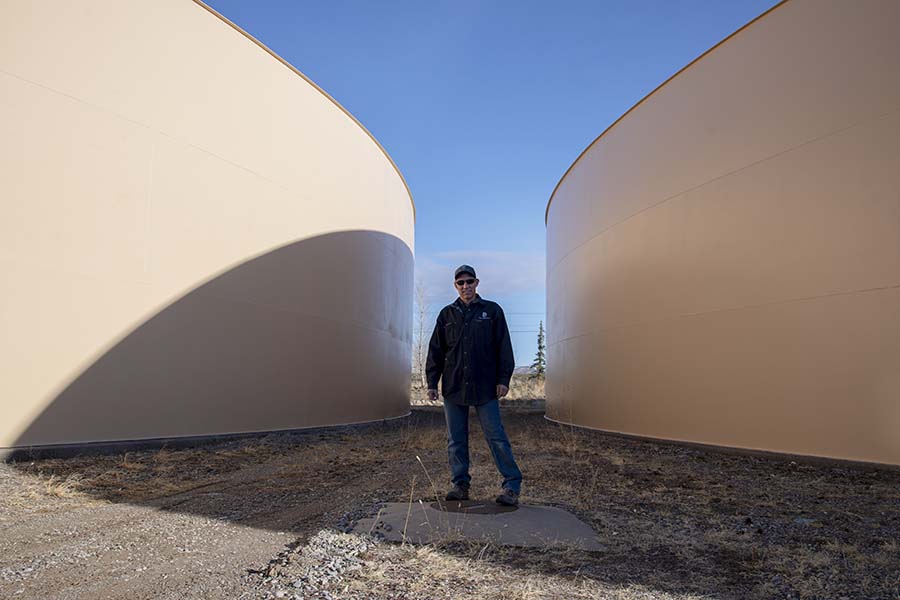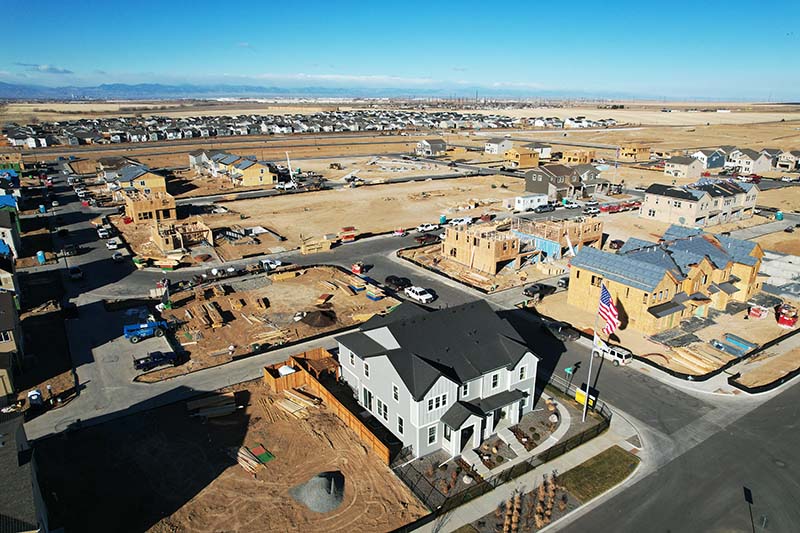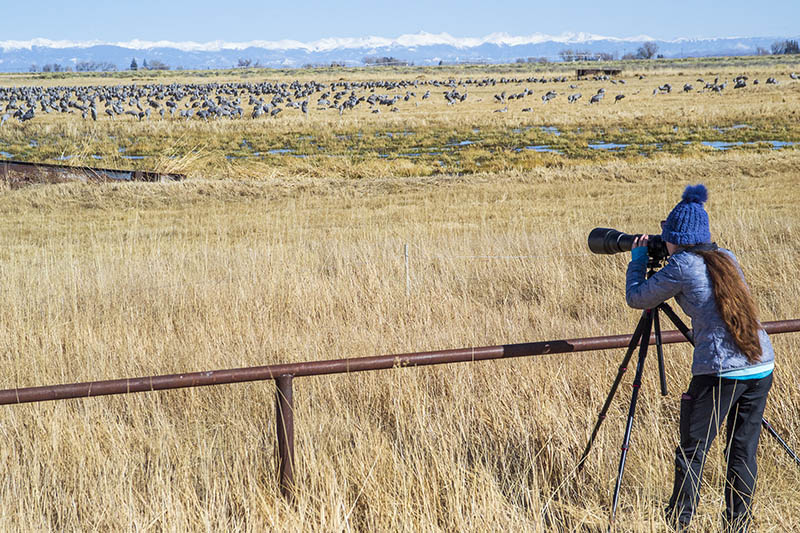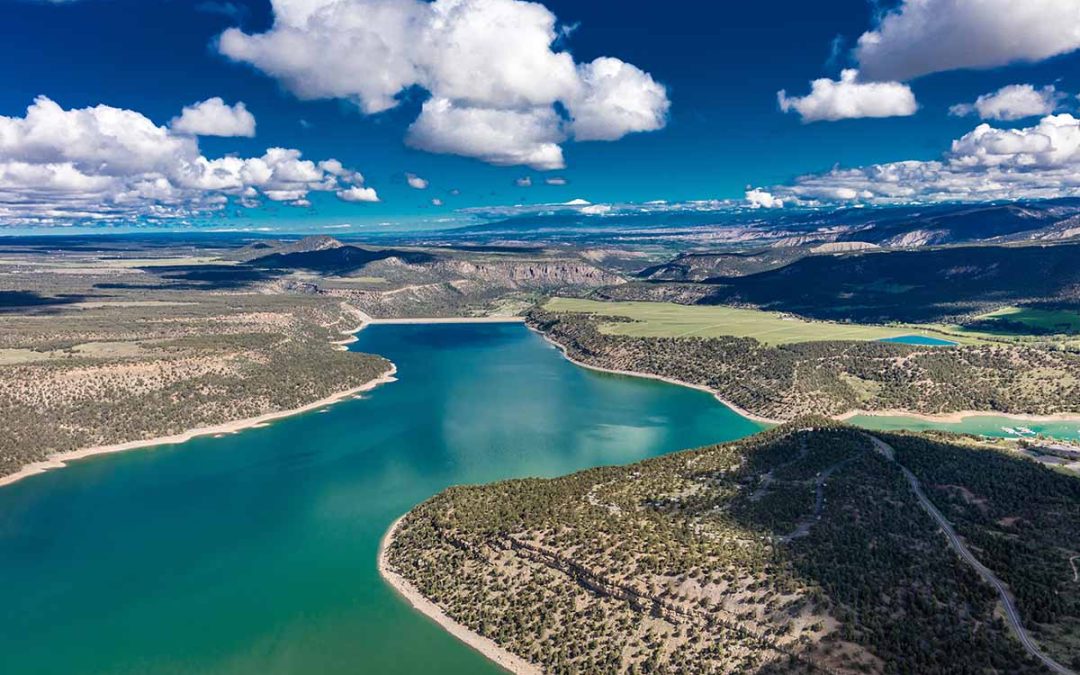How the state’s new plan blazes a trail to manage water risk and brings stakeholders along
Since 2015, the Colorado Water Plan has helped communities navigate the challenges of water scarcity. With the 2023 update to this landmark roadmap in hand, the question remains: How might it spur meaningful change across our cities, farms, and cherished watersheds?
Five miles long and surrounded by juniper-covered mesas, Ridgway Reservoir contains untold treasures—if you’re an angler who dreams of hooking gem-colored trout. Rainbows and browns, as well as kokanee salmon, thrive in this impounded segment of the Uncompahgre River south of Montrose, Colorado. Paddleboarders and campers also flock to its idyllic waters, yet ever since it was built in 1987, there’s been a significant problem with the reservoir: It was never connected to the region’s municipal water treatment and supply system.
When Ridgway Reservoir was completed, municipal supply was intended to be part of its purpose, but over the following decades, the cost of piping water to the region’s water treatment plant some 25 miles away in Montrose stymied municipal connections to the 18,000 acre-feet of water reserved in Ridgway for municipal and industrial use. And because Montrose, Delta, Olathe and other area communities weren’t experiencing water shortages, the dollar investment didn’t seem worth the return.
But the 2000s brought new pressures on the Uncompahgre Valley and the rest of Colorado. Drought, aridification, and the growing threat of catastrophic wildfires made the communities aware of their singular reliance on the Gunnison River and one water treatment plant. What if natural catastrophes took that water offline, even temporarily?
The region’s Project 7 Water Authority, which serves 60,000 water users in Ouray, Montrose and Delta counties, decided that it couldn’t expose area water users to a potential shut-down. This summer, Project 7 will break ground on a pioneering new water treatment plant just downstream from Ridgway Reservoir, south of Colona, that will use gravity-fed pipes to deliver a second, backup source of water to Uncompahgre Valley municipalities. Plans to revive the vision for this treatment plant, securing a second water supply to minimize risk and instability arose in 2018, following a risk assessment completed by Project 7 in 2014.
“We wanted to be proactive, not reactive,” explains Project 7 general manager Adam Turner. There’s much more state support for water planning today than there was in 1987. Now Coloradans have a central document that supports projects such as the construction of the Ridgway plant: the Colorado Water Plan.
“Watching the water plan get developed, I’m much more aware of all the pressures on our supply,” Turner says. With the dialogue of the water plan in his mind, and statewide water planning efforts happening in parallel with the recently completed risk assessment, “all these things came together,” he says.

Adam Turner, general manager of the Project 7 Water Authority, poses at the authority’s existing water treatment plant in Montrose, Colorado. Later this year, Project 7 will break ground on a new water treatment plant to provide a backup source of water to Uncompahgre Valley municipalities. Photo by William Woody
Although the Uncompahgre Valley’s communities aren’t currently facing water shortages, they are confronting water supplies that look increasingly inadequate to continue to meet the region’s needs. Moreover, catastrophic wildfires and other climate impacts represent a growing threat to water certainty if Coloradans don’t plan for and address them. This poses a risk to both cities and to the places the water will come from.
Projections issued by the Colorado Water Conservation Board (CWCB) show demand for water increasing across all sectors. If Coloradans don’t take action, households and industry could face critical water shortages, farm and ranch land could be permanently dried up, and competition for water could exacerbate environmental concerns. The water plan frames up these risks alongside actions that Coloradans can take to reduce them.
In 2013, then-Governor John Hickenlooper called for the CWCB to create the first-ever Colorado Water Plan, which analyzed the gap between the state’s projected growth and its future supply of water. Thirty months of meetings involving stakeholders from Colorado’s nine basin roundtables, which represent the state’s eight major river systems and the Denver metro area, resulted in a plan published in 2015. It articulated a new, more collaborative paradigm for managing water across the state, describing goals for increased and improved water storage, conservation and water reuse, watershed health, disaster management, agricultural viability, recreational use, environmental protection, and public outreach and education.
The CWCB was also tasked with implementing the plan using largely the same tools that the agency has always had—providing funding, offering technical support, and supplying data and information to help inform local decisions. Notably, the CWCB is not a regulatory agency and can’t require any agency, group or local authority to take action. However, through the more than 835 water projects funded through various CWCB grant programs since 2015, and many conversations along the way that have influenced work at the local level—like Project 7’s treatment plant to manage risk—the agency learned what made the initial plan successful and what elements didn’t work.
The 2023 update to the Colorado Water Plan refreshes the document’s relevancy and promises to spur new collaboration around water solutions. It’s an all-hands call to action, given the high stakes of water shortages.
“We are facing the slowest-moving natural disaster,” observes Josh Kuhn, water campaign manager for Conservation Colorado. His nonprofit has been involved with the Water For Colorado coalition which encouraged public comment on the draft water plan and advocates for the water plan and basin implementation plans to address conservation, the environment, recreation and equity. To fend off catastrophe, communities have no panacea—but at least they have a plan. Here’s how it works.
Increased Accountability Toward a Shared Vision
If Colorado’s 2015 water plan placed the state on the vanguard of water preparedness, alongside governments such as California and Idaho that had already crafted comprehensive statewide plans for water management and development, the 2023 plan blazes a new trail in ways that embrace Colorado’s legacy, its unique qualities as a local control state, and the range of forecasted future scenarios that lie ahead.
The new plan reinforces the protection of the state’s peoples and cultures, local food and agricultural exports, small rural towns, headwaters communities and major city centers, as well as forests, waterways, wildlife, and the recreation and tourism activities associated with them. How to protect all of this in a state where decision making around water happens at the local level?
“The original Colorado plan set specific targets and measurable objectives,” explains Russ Sands, chief of the CWCB’s Water Supply Planning Section. However, it did not clearly assign accountability for achieving its measurable objectives.
The new plan sets long-term visions for the state’s future focusing on four areas: vibrant communities, robust agriculture, thriving watersheds, and resilient planning. The plan then backs up those aspirational goals by offering a suite of 100 actions to help get there. While the plan sets a big-picture vision, it will be implemented, in large part, by local water users and decision makers.
The updated water plan provides more than 50 examples of work that stakeholders can undertake to help achieve its vision and that could be supported by Water Plan Grants. Those partner actions are balanced by 50 agency actions the CWCB will implement through convening discussions, highlighting critical issues, funding local collaborative projects, and supporting on-the-ground efforts with tools, research and other initiatives. Those CWCB goals will dictate the agency’s work plan going forward. Partner actions, on the other hand, offer ideas for projects that could be eligible for grant funding and examples of ways individuals can engage on various scales—from learning more and attending meetings to organizing a new coalition or project.
Much of the plan’s power to drive change ultimately rests in local hands. “Some plans are very prescriptive and take a top-down approach,” says Greg Felt, the Arkansas River Basin representative on the CWCB board. “Here, we operate more from the ground up.” For example, the state doesn’t build water projects; instead, it leans on local entities and coalitions of partners to identify projects and solutions that address their unique water needs. On a regional level, each basin roundtable updates their basin implementation plan (BIP) to identify local water and river management needs and recruit regional players who can implement action items. “Things start at the local level, and CWCB helps bring those projects across the finish line,” says Felt.
And because the Colorado Water Plan emphasizes the importance of collaboration among stakeholders, CWCB expects its grant recipients to demonstrate that their projects provide multiple benefits across various water users and groups. That’s forced people to change their siloed habits, says Lauren Ris, CWCB’s deputy director.
Since 2017, Colorado Water Plan Grants, funded in varying amounts annually, have totaled more than $61 million. They’ve funded projects proposed by ditch companies, non-profits, small businesses, institutes of higher learning, and municipalities—often working together. Thus, ranchers, for example, who want water plan money to replace a headgate or diversion might partner with Colorado Parks and Wildlife, environmentalists and recreational entities to propose a project together that could benefit wildlife, paddlers and ranchers.
“Across the state, the need for water projects is so great that our funding can’t achieve it all,” explains Ris. “So we get a bigger bang for our buck when we see people pooling benefits and collaborating.”
That multi-benefit expectation has created valuable opportunities for non-consumptive water users. Recreationists and environmentalists, who typically rely on water that isn’t diverted from water sources or removed from the system, hence “non-consumptive,” have more opportunities to participate as partners in water management decisions instead of getting boxed out. Historically, these groups weren’t often included in projects, instead following and reacting to decisions of entities holding traditional consumptive water rights.
“The prior appropriation system is a phenomenal system for administering water rights,” says Felt. “But it doesn’t go beyond the basic needs of any entity. The Colorado Water Plan has provided ways to weave non-consumptive uses into the program and establishes a more holistic way of investing in water development.”
Wildfires, for example, can have dire consequences for all Coloradans, from agricultural producers to anglers to innkeepers to homeowners. So the Colorado Water Plan and its 2023 update establish the health of watersheds and forests as a top priority—one that’s bigger and more universal than any single water right. “We will all be diminished to the extent to which we ignore forest health,” says Felt.
By working together and seeking partners among various water users, Coloradans are also achieving significant local victories that promise to make the state’s water future more secure. Perhaps no win seems more surprising than Colorado’s agreement with Kansas over water storage in the John Martin Reservoir.
Regional Collaboration to Maximize Existing Storage for Multiple Uses
Kansas and Colorado haven’t always felt particularly chummy when it comes to the topic of water—particularly the Arkansas River’s eastbound flow across the state line. Negotiated in 1948, the Arkansas River Compact between the neighboring states promised that development in Colorado past that year would not diminish flows to Kansas, and that river water stored in John Martin Reservoir, in southeastern Colorado, some 50 miles west of the Kansas state line, would be divided between Kansas (receiving 40%) and Colorado (60%). The compact only concerns water quantity, not quality.
In 2016, when representatives from Colorado’s portion of the Arkansas River started talking with the Arkansas River Compact Administration (ARCA) about letting Colorado water users increase their storage quantities in John Martin Reservoir, they heard from plenty of nay-sayers.
“People who were familiar with Kansas said we were wasting our time,” recalls Jack Goble, now general manager of the Lower Arkansas Valley Water Conservancy District.
Yet the 2015 Colorado Water Plan had urged Colorado water managers to make the most of all the reservoir storage they could find as a key strategy for meeting current and future water demand. John Martin Reservoir was definitely underutilized.
“It fills once every 20 years,” says Goble. “Usually, the vast majority of space behind the dam is not filled, so it represented a great opportunity to increase stored water without any associated construction cost.” Storing more water in the reservoir would mean that Colorado’s Arkansas Basin water users could manage their water more effectively and transparently, by allowing new efficiency improvements, cooperative water sharing, lease-fallowing arrangements, and more—helping the agricultural community. All Colorado had to do was persuade Kansas to agree.
In 2017, the Colorado team approached Kansas with a collective proposal that represented many Colorado water users, rather than having each entity approach Kansas solo. Using a $50,000 grant from the CWCB, the Lower Arkansas Water Conservancy District conducted a study that collected estimates from water users who wanted to store water in John Martin. Two more CWCB grants supported the creation of a model that projected potential effects from increased storage on current and future operations. Colorado representatives met some 30 times to discuss these estimates and models with ARCA’s Kansas council. In summer 2022, ARCA agreed to a trial account allowing water users who previously had no storage in John Martin to store up to 20,000 acre-feet of multi-purpose water in the reservoir at a time. Kansas receives 12.5% of that new pool of water as a storage charge for allowing the deliveries. The storage agreement will terminate in 2028 unless extended by ARCA.
Colorado’s aim was water quantity, but quality was what drove interest from Kansas, says Goble. “Their intent is to use releases from the reservoir to improve water quality as it approaches the state line,” he explains. Plus, water efficiency improvements, facilitated in Colorado through the new storage pool, will mean that fewer contaminants leach from the soil and move downstream.
Such a compromise probably couldn’t have happened without the Colorado Water Plan—which directed stakeholders in the Arkansas River Basin to “Promote multiple uses at existing and new storage facilities.” Explains Rachel Zancanella, division engineer for the Arkansas River Basin, “The storage was already there. This account allowed Colorado water users to take advantage of an already-constructed and paid-for vessel, at no additional dollar cost to them.” Plus, the plan’s emphasis on partnerships inspired the collaborative approach that eventually led to parameters both states could agree on.
This new approach of collaboration allowed the John Martin pilot project to move forward while honoring the existing compact—and helped the region make significant gains in water security. But agricultural regions aren’t the only ones that are trying out new ways of approaching old problems. City and county governments are also using the plan to help them re-think growth and development.
Sustainable Water Management & Integrated Water & Land Use Planning in Arapahoe County
All along the Front Range, municipalities are running out of space for new construction. Limited by the foothills to the west, the Denver metropolitan area has expanded to the north and south, where its growth has merged with existing communities. Consequently, some of the fastest-growing areas are on the eastern edge of the urban corridor, such as in Arapahoe County, Colorado’s third-largest county by population, with 655,000 residents.

When complete, the Sky Ranch Villas development east of Aurora, Colorado, will house 3,400 residential units in unincorporated Arapahoe County. This is one of several developments underway in this fast-growing region where the county is paying close attention and connecting the dots between water supply and land use planning. Photo by Hyoung Chang/The Denver Post/Getty Images
Back in 2001, when projections forecast intensive growth along Interstate 70, Arapahoe County conducted a groundwater study beneath its unincorporated areas to the east. That assessment prompted the county to adopt guidelines requiring future development to establish a 200-year proof of groundwater supply, a voluntary increase from the 100-year rule that remains the state requirement.
“The Colorado Water Plan prompted us to go beyond minimum requirements to develop a more comprehensive approach to conservation and reuse,” says Loretta Daniel, the county’s long range program planning manager. “We’ve really started to focus on the relationship between land use and water, especially given the additional pressures of climate change,” Daniel continues.
In 2018, the county updated its comprehensive plan to reflect the need to reduce water consumption and develop water reuse policies, goals that were also outlined in the state water plan.
The updated Colorado Water Plan calls for transformative landscape change and more integrated land use planning to reduce water use and to better coordinate the funding and planning of this work. In keeping with that idea, Arapahoe County is increasing communication among various water users within the county, from water suppliers to the City of Aurora. “We’ve developed a more strategic and collective approach to water in the county, and with everybody knowing what everybody else is doing, we can make better forecasts about water demand,” Daniel says.
Another step in this approach was launching a comprehensive study of the groundwater that underlies the entire county, not just the unincorporated portions. Arapahoe County initiated the 18-month study in January 2023, using a $125,000 grant from CWCB and $300,000 from the county’s American Rescue Plan Act (ARPA) allocation. Not only will the study evaluate groundwater resources but it will also investigate best practices in water-efficient landscape regulations and potential systems for water reuse, important tenets in the updated state water plan.
“Arapahoe County is really living up to the call to action from the Colorado Water Plan,” says CWCB’s Ris. “They are integrating land use planning and water planning by working with water providers to strengthen their comprehensive plan update as well as revamping their landscape codes to reflect a 21st-22nd century approach to sustainable water management,” Ris continues. “Additionally, they are taking steps to adapt to climate change realities by replacing non-essential turf with climate and water-wise landscapes.”
Daniel acknowledges that such changes may ultimately limit development. “The bigger question that really comes out of all this is, how much will water limit our growth?” she asks. For the smaller communities on Arapahoe County’s eastern edge, those limitations may be significant.
Ultimately, Daniel expects the study to prompt an array of changes to county codes and zoning regulations, perhaps ones implementing new regulations on turf lawns and the adoption of a 300-year rule for groundwater. “We know that this groundwater is a finite resource that’s really not recharged except at the foothills. So how responsible are we going to be to future generations as we’re looking at this finite resource?” she asks.
But while development sometimes depends on groundwater, a critical source of water supply in many areas, surface water is the dominant use of water in the state and our environments, wildlife and recreation rely primarily on surface watersheds. The Col
Speaking Up to Protect Watershed Health
“We can’t separate Colorado’s ability to thrive from the health of our watersheds,” says Abby Burk, Western Rivers regional program manager for Audubon Rockies.
Of course, birders share an unusual fondness for the water-fed places where kingfishers and other species thrive. So when the state collected public input on the creation of its 2015 Water Plan, Audubon’s network contributed about 20% of the general comments on priorities and direction for the document. Last year, the membership weighed in again, with 3,400 people signing the National Audubon Society’s messaging about the draft update.

A birder watches sandhill cranes in Monte Vista, Colorado. By engaging birders at their point of interest, Audubon encouraged public participation and comment on the state water plan. Photo by Brian Williams/Valley Publishing Inc.
“We all enter the water conversation at different points of interest,” explains Burk. Anglers might look to Trout Unlimited for direction on watershed management. Birders listen to the Audubon Society. “At a time when we all need to lean in and learn more about Colorado’s water, Audubon plays a critical role in keeping people engaged and involved. We speak to people at their point of entry,” she adds.
But it’s a two-way conduit, Burk explains. Audubon works to broadcast environmental needs to CWCB. “We’ve encouraged CWCB to move forward with river health assessments that document the current state of ecological health,” Burk offers as an example. Not only does that data help Audubon and its partners manage rivers in a sustainable way, but it also helps them restore rivers after wildfire.
Birders already believe in the importance of healthy watersheds. But by including that emphasis in the Colorado Water Plan, the environment becomes a priority that’s shared by all. Because CWCB loans and grants prioritize projects that identify multiple benefits—including environmental and recreational gains—water plan funding has a pathway for reaching natural ecosystems.
And all can read and understand the plan, thanks to its low-jargon, accessible language. “Compared to other states’ plans, this is a very inviting document that’s not overly technical,” says the Arkansas River’s Greg Felt.
“The hope is that people will feel comfortable enough to wade in, so to speak,” Felt puns. After all, water is a notoriously complicated topic. The Colorado Water Plan was written to remove some of that mystery, and ideally, pique residents’ desire to get involved.
That engagement might take place through a trusted non-governmental organization such as the Audubon Society, forest health collectives, watershed groups, and local or regional committees that seek participation from informed residents who care. “People want in,” says Felt, “And we think of this document as a bridge to involvement.”
A freelance writer living in Steamboat Springs, Kelly Bastone covers water, conservation and the outdoors for publications including Outside, AFAR, 5280, Backpacker, Field & Stream, and others.


 Print
Print